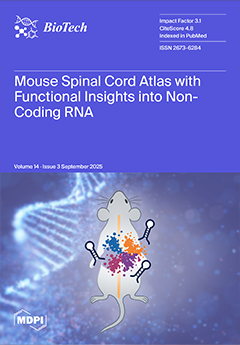Vanilla is a highly valuable spice in multiple industries worldwide. However, it faces a serious problem due to a disease known as root and stem rot, caused by the fungus
Fusarium oxysporum f. sp.
vanillae. Little is known about the pathogenicity mechanisms
[...] Read more.
Vanilla is a highly valuable spice in multiple industries worldwide. However, it faces a serious problem due to a disease known as root and stem rot, caused by the fungus
Fusarium oxysporum f. sp.
vanillae. Little is known about the pathogenicity mechanisms this fungus employs to establish the disease, making it imperative to elucidate mechanisms such as the presence of pathogenicity effectors in its genome. The aim of the present study was to determine the presence of the
SIX gene family in the genome of three strains of
F. oxysporum associated with root rot: two pathogenic strains and one non-pathogenic endophyte strain. Additionally, the complete effectorome of these strains was predicted and compared to exclude effectors present in the endophytic strain. Our results show that only the
SIX9 gene is present in the strains associated with the disease, regardless of their pathogenic nature. Furthermore, no variation was observed in the
SIX9 gene among these strains, suggesting that
SIX9 is not involved in pathogenicity. Instead, we identified 339 shared effectors among the three strains, including the non-pathogenic strain, strongly suggesting that these genes are not relevant for establishing root rot but may play a role in endophytic colonization. The highly virulent strain IXF41 exhibited eight exclusive pathogenicity effectors, while the moderately virulent strain IXF50 had four. Additionally, one effector was identified as shared between these two strains but absent in the endophytic strain. These effectors and their promoters were characterized, revealing the presence of several
cis-regulatory elements responsive to plant hormones. Overall, our findings provide novel insights into the genomic determinants of virulence in
F. oxysporum f. sp.
vanillae, offering a foundation for future functional studies and the development of targeted disease management strategies.
Full article






